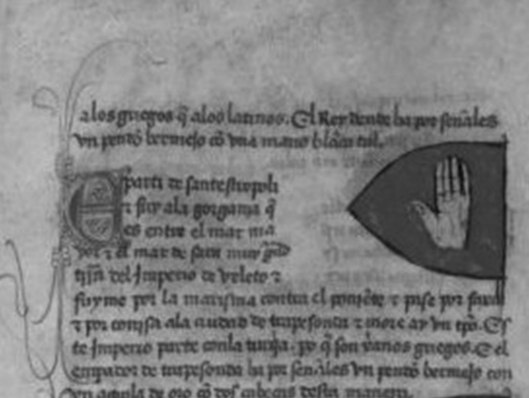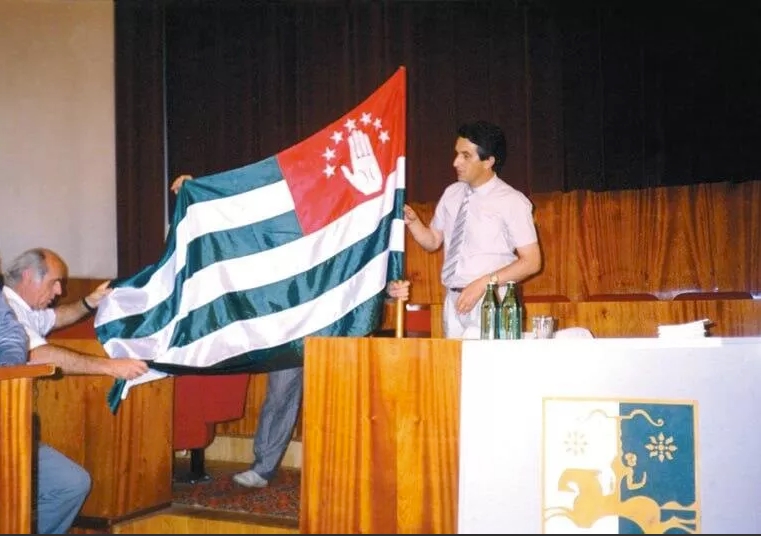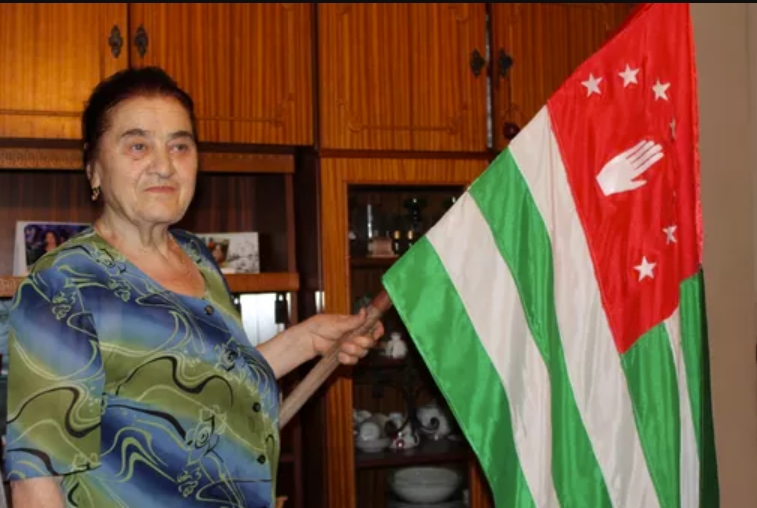The Story of Abkhazia's Flag: A Symbol of Independence

On 23 July 1992, the Supreme Council of Abkhazia approved the National Flag and Coat of Arms of the Republic of Abkhazia.
SUKHUM / AQW'A — Abkhazia is celebrating the Day of the National Flag of the Republic. This year marks the 31st anniversary of the flag of Abkhazia.
On 23 July 1992, the Supreme Council of Abkhazia approved the National Flag and Coat of Arms of the Republic of Abkhazia. These symbols were designed by the artist Valery Gamgia, drawing inspiration from the flag of the 1918 Mountainous Republic of the Northern Caucasus. The task of sewing the national symbols was entrusted to workers at the "Fashion House" factory in Sukhum. They carried out the order in secret, away from colleagues and under threat of punishment. The following details the journey of how Abkhazia got its flag, how it was made, and what it symbolises.
The inception of the Abkhazian Flag
The modern State Flag of Abkhazia was approved during a session of the Supreme Council of the Republic amidst a tense standoff between the Abkhaz and Georgian factions of the deputies.
The establishment of the national symbols and the renaming of the country from the Abkhaz Autonomous Soviet Socialist Republic to the Republic of Abkhazia was only possible after the Abkhazian ASSR Constitution of 1978 was rescinded and the Constitution of the SSR Abkhazia of 1925 was reinstated. According to this primary law, the approval of the state's name and symbols did not require a two-thirds majority. Consequently, deputies favouring Abkhaz interests were able to pass the decision with a simple majority, without the participation of Georgian parliamentarians.
Symbolism of the Abkhazian Flag
Abkhaz artist Valery Gamgia designed the draft of the modern Abkhazian flag. In it, he depicted a symbol of Abkhaz statehood known since the Abkhaz Kingdom of the 8th - 10th centuries. This symbol is an open white palm on a red background, an image that was flown over Sebastopolis - the precursor to modern Sukhum - 12 centuries ago.

Flag image the ruler of Savastopol handwritten "Book of knowledge about all the kingdoms" (1359–1360).
The green and white stripes on the Abkhazian flag, as conceived by the author, refer to the flag of the Mountain Republic, which included Abkhazia and existed in 1918. The colour white symbolises spirituality, and green represents youth and life.
The seven five-pointed stars above the palm represent the seven main regions of historical Abkhazia: Sadzen (Dzhigetia), Bzyb, Guma, Abzhywa, Samurzakan, Dal-Tsabal, Pskhu-Aibga.

+ On the Historical Symbolism of the State Flag of the Republic of Abkhazia
The Implementation of the Flag Design
Having prepared the design, Gamgia handed the task of bringing the flag to life to Arda Arshania–Ardzinba, a tailor from the "Fashion House" in Sukhum. The flag she stitched became the one presented to the deputies of the Supreme Council and approved as the state symbol at the historic session 27 years ago.

23 July 1992. Vladislav Ardzinba, serving as the Chairman of the Supreme Council of the Abkhaz ASSR, led the parliamentary session in which the Republic of Abkhazia was declared, and its national flag and coat of arms were ratified.
The primary challenge for the tailor and her assistants, Shalva Zantaria and Lidia Tarkil, was to accurately reproduce the designated proportions. Specifically, the width of the flag had to be half its length, and the width of the red rectangle at the top of the flag should match the width of its three stripes.
Arda Arshania–Ardzinba carried out the vital order at home, in secret from her colleagues, many of whom were of Georgian nationality and were opposed to the campaign to establish Abkhazian state symbols. She recalls receiving numerous threats directed at her and the director of the factory shortly after she began sewing the flag.

Arda Arshania-Ardzinba
"Many threatening calls started to come in, making it unsafe to work at the factory. Loaded with rolls of fabric and sketches, they sent me and my two assistants to work from home," shared the tailor.
The process was under the constant supervision of Valery Gamgia.
"The artist spent many hours with us, overseeing the process. At times, he would ask us to reduce the amount of green, add more red, or adjust something else, as we sought the perfect proportions," Arshania–Ardzinba recalled.

The Fate of the Flag
Artist Valery Gamgia brought various versions of the flag for review by the parliamentary commission, whose members also suggested modifications. The final version of the flag was approved by Vladislav Ardzinba, Chairman of the Supreme Council of the Abkhaz ASSR. After approval, the silk flag, measuring 1.5 metres by 70 centimetres, was presented at a public gathering in Sukhum.
Recalling the Unveiling of the Flag
"People from all corners of Abkhazia gathered at the Republican Stadium in Sukhum. Our first flag was brought to the assembly by a horseman from the village of Lykhny. Afterwards, the flag was carried along the entire seafront of the capital," reminisces the tailor, Arshania-Ardzinba.
A mere three weeks after the approval of the state symbols of Abkhazia, on 14 August 1992, the troops of the State Council of Georgia entered the republic. This marked the start of a war that would last over a year and claim thousands of lives. From the very first days of the conflict, Abkhazian warriors carried the green-and-white flag, which became a symbol of their struggle for freedom and independence.

As military operations commenced, the family of Arda Arshania-Ardzinba was forced to leave Sukhum, and she lost track of the first flag of the republic. Media reports suggested that the flag she sewed was handed to the prominent Abaza public figure, Oleg Etlukhov, during the first Congress of the Abkhaz-Abaza people in the village of Lykhny in October 1992. Two decades later, in 2013, the flag made its return to Abkhazia.